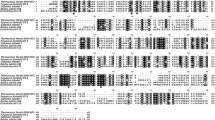Abstract
l-Aspartate 4-decarboxylase (Asd) is a major enzyme used in the industrial production of l-alanine. Its gene was cloned from Pseudomonas sp. ATCC 19121 and characterized in the present study. The 1,593-bp asd encodes a protein with a molecular mass of 59,243 Da. The Asd from this Pseudomonas strain was considerably homologous to other Asds and aminotransferases, and has evolved independently of these enzymes from gram-positive microbes. Productivity rate of the C-terminal His-tagged fusion Asd was at 33 mg/l of Escherichia coli transformant culture. The kinetic parameters K m and V max of the fusion protein were 11.50 mM and 0.11 mM/min, respectively. Gel filtration analysis demonstrated that Asd is a dodecamer at pH 5.0 while 4.4 % of the recombinant protein dissociated into dimer when the pH was increased to 7.0. Asd exhibited its maximum activity at pH 5.0 and specific activity of 280 U/mg, and remained stable over a broad range of pH. The optimum temperature for Asd reaction was 45 °C, and 92 % of the activity remained when the enzyme was incubated at 40 °C for 40 min. This enzyme did not have any preferred divalent cation for catalysis. The recombinant Asd also exhibited aminotransferase activity when d,l-Asp, l-Glu, l-Gln, and l-Ala were utilized as substrates. However, the decarboxylation activity of l-aspartate was 2,477 times higher than its aminotransferase activity. The present study is the first investigation on the important biochemical properties of the purified recombinant Asd.





Similar content being viewed by others
References
Abe K, Ohnishi F, Yagi K, Nakajima T, Higuchi T, Sano M, Machida M, Sarker RI, Maloney PC (2002) Plasmid-encoded asp operon confers a proton motive metabolic cycle catalyzed by an aspartate-alanine exchange reaction. J Bacteriol 184:2906–2913
Altschul SF, Madden TL, Schaffer AA, Zhang J, Zhang Z, Miller W, Lipman DJ (1997) Gapped BLAST and PSI-BLAST: a new generation of protein database search programs. Nucleic Acids Res 25:3389–3402
Bowers WF, Czubaroff VB, Haschemeyer RH (1970) Subunit structure of l-aspartate β-decarboxylase from Alcaligenes faecalis. Biochemistry 9:2620–2625
Bradford MM (1976) A rapid and sensitive method for the quantitation of microgram quantities of protein utilizing the principle of protein-dye binding. Anal Biochem 72:248–254
Chen CC, Chou TL, Lee CY (2000) Cloning, expression and characterization of l-aspartate β-decarboxylase gene from Alcaligenes faecalis CCRC 11585. J Ind Microbiol 25:132–140
Chibata I, Kakimoto T, Kato J (1965) Enzymatic production of l-alanine by Pseudomonas dacunhae. Appl Microbiol 13:638–645
Crawford LV (1958) Studies on the aspartic decarboxylase of Nocardia globerula. Biochem J 68:221–225
Dimroth P, Schink B (1998) Energy conservation in the decarboxylation of dicarboxylic acids by fermenting bacteria. Arch Microbiol 170:69–77
Dogan B, Boor KJ (2003) Genetic diversity and spoilage potentials among Pseudomonas spp. isolated from fluid milk products and dairy processing plants. Appl Environ Microbiol 69:130–138
Dunathan HC (1966) Conformation and reaction specificity in pyridoxal phosphate enzymes. Proc Natl Acad Sci USA 55:712–716
El-Rahmany TA (1994) Comparison of l-aspartate 4-carboxy-lyases of Cunninghamella elegans and Penicillium citrinum. Microbiol Res 149:253–257
Graber R, Kasper P, Malashkevich VN, Strop P, Gehring H, Jansonius JN, Christen P (1999) Conversion of aspartate aminotransferase into an l-aspartate β-decarboxylase by a triple active-site mutation. J Biol Chem 274:31203–31208
Laemmli UK (1970) Cleavage of structural proteins during the assembly of the head of bacteriophage T4. Nature 227:680–685
Nishimura JS, Manning JM, Meister A (1962) Studies on the mechanism of activation of aspartic acid β-decarboxylase by α-keto acids and pyridoxal 5′-phosphate. Biochemistry 1:442–447
Novogrodsky A, Nishimura JS, Meister A (1963) Transamination and β-decarboxylation of aspartate catalyzed by the same pyridoxal phosphate-enzyme. J Biol Chem 238:PC1903–PC1905
Rathod PK, Fellman JH (1985) Identification of mammalian aspartate-4-decarboxylase. Arch Biochem Biophys 238:435–446
Rozzell JD (1991) Method and compositions for the production of l-alanine and derivatives. US Patent No. 5,019,509
Saitou N, Nei M (1987) The neighbor-joining method: a new method for reconstructing phylogenetic trees. Mol Biol Evol 4:406–425
Sambrook J, Fritsch EF, Manniatis T (1989) Molecular cloning: a laboratory manual. Cold Spring Harbor Laboratory Press, New York
Tate ST, Meister A (1970) Regulation and subunit structure of aspartate β-decarboxylase. Studies on the enzymes from Alcaligenes faecalis and Pseudomonas dacunhae. Biochemistry 9:2626–2632
Thompson JD, Gibson TJ, Plewniak F, Jeanmougin F, Higgins DG (1997) The ClustalX windows interface: flexible strategies for multiple sequence alignment aided by quality analysis tools. Nucleic Acids Res 25:4876–4882
Wilson EM, Kornberg HL (1963) Properties of crystalline l-aspartate 4-carboxy-lyase from Achromobacter sp. Biochem J 88:578–587
Acknowledgements
This work was supported by grants 90AS-2.1.1-FD-Z4(1) and 91AS-3.1.1-FD-Z5(3) from the Council of Agriculture, and was partially supported by grant NSC92-2313-B-002-092 and NSC94-2313-B-002-049 from the National Science Council, Taipei, Taiwan.
Author information
Authors and Affiliations
Corresponding author
Rights and permissions
About this article
Cite this article
Wang, NC., Lee, CY. Molecular cloning of the aspartate 4-decarboxylase gene from Pseudomonas sp. ATCC 19121 and characterization of the bifunctional recombinant enzyme. Appl Microbiol Biotechnol 73, 339–348 (2006). https://doi.org/10.1007/s00253-006-0475-6
Received:
Revised:
Accepted:
Published:
Issue Date:
DOI: https://doi.org/10.1007/s00253-006-0475-6




